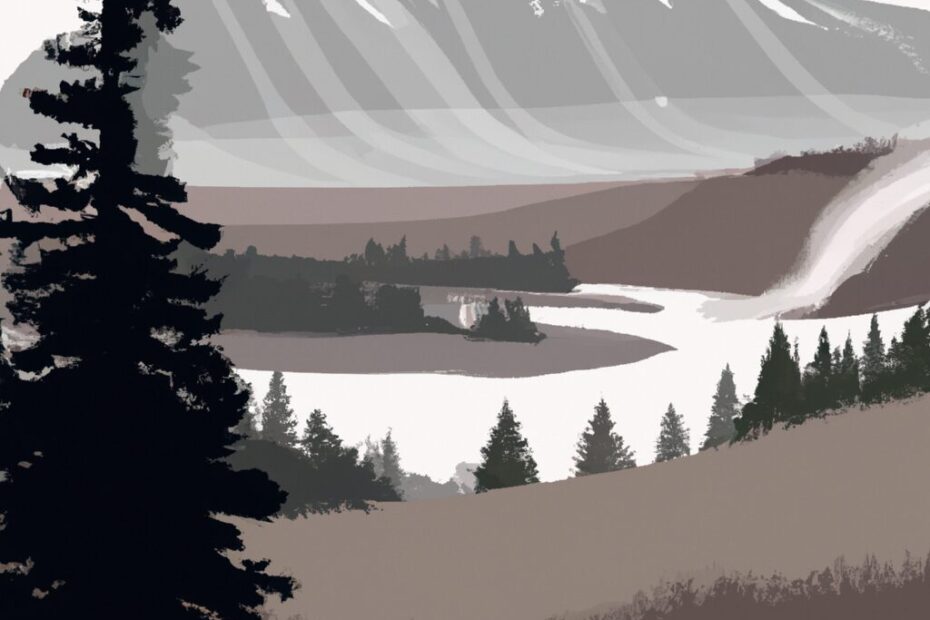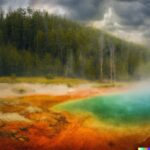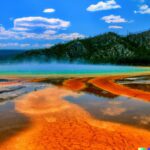Yellowstone National Park is famous for its breathtaking geysers, natural hot springs that erupt with boiling water and steam. In this article, we will explore what geysers are, where you can find them, and what makes Yellowstone’s geysers so unique.
We will cover the different types of geysers in Yellowstone, what causes them to erupt, and how they are monitored for safety. Geysers are a rare and fascinating natural phenomenon, and Yellowstone is home to over 500 of them, making it the largest concentration of geysers in the world. These geothermal features are caused by underground heat and pressure, creating eruptions of hot water and steam that can reach heights of over 300 feet.
Yellowstone’s geysers are constantly changing and evolving, with new geysers forming and others becoming dormant. Old Faithful, one of the park’s most famous geysers, erupts approximately every 90 minutes, making it a popular attraction for visitors. “Old Faithful” was named in 1870 by the Washburn Expedition because of its consistent eruptions.
However, approaching a geyser can be extremely dangerous, as the water can reach temperatures of up to 400 degrees Fahrenheit. Yellowstone’s geysers are closely monitored by park rangers, who use specialized equipment to track changes in activity and ensure the safety of visitors. Yellowstone’s geysers are a reminder of the incredible power and beauty of nature, and they should always be admired from a safe distance.
Some interesting facts about Yellowstone’s geysers include the fact that they are not just limited to the park’s famous geyser basins. Geysers can also be found in other areas of the park, including along the Firehole River and in the Norris Geyser Basin. Additionally, Yellowstone’s geysers are not the only geothermal features in the park; there are also hot springs, mud pots, and fumaroles to explore.
In conclusion, Yellowstone’s geysers are a unique and awe-inspiring natural wonder. Whether you’re visiting the park in person or learning about them from afar, these geysers are sure to leave a lasting impression. So, next time you see a geyser erupt, remember the incredible forces at work beneath the surface and appreciate the beauty of nature’s power.
What Are Geysers?
Geysers are hydrothermal features found in places with volcanic and geothermal activity, such as Yellowstone National Park.
Geysers are formed when underground water, heated by magma, reaches the boiling point and creates pressure, eventually leading to a powerful eruption of steam and hot water. This volcanic and geothermal activity in Yellowstone National Park makes it a hotspot for these spectacular thermal features.
Geysers serve as natural indicators of the presence of underground volcanic activity and contribute to the understanding of Earth’s processes. Their eruptions, like the famous Old Faithful geyser, attract millions of visitors, showcasing the magnificence and power of geothermal energy.
Where Can You Find Geysers?
Geysers can be found in various locations worldwide, but one of the most famous and geologically significant areas is Yellowstone National Park in Wyoming.
What Makes Yellowstone Geysers Unique?
Yellowstone’s geysers are unique due to the park’s exceptional geological history, which has shaped a landscape with unparalleled hydrothermal features and biodiversity.
Location and Formation
The location and formation of geysers are closely linked to geological processes and the presence of intricate hydrothermal systems within the earth’s crust.
Hydrothermal systems are essential for the formation of geysers, as they heat groundwater deep within the earth. As the water rises, it encounters obstacles and builds up pressure underground. Eventually, this pressure causes the water to erupt through a vent, creating the iconic geyser eruption.
The presence of fissures, fractures, and geological faults in the earth’s crust also play a crucial role in the formation and sustainability of hydrothermal systems. These features allow for the continuous activity of geysers over extended periods of time.
Types of Geysers in Yellowstone
Yellowstone National Park hosts various types of geysers, including those connected to hydrothermal vents, each exhibiting unique characteristics and behaviors.
These geyser types, such as cone geysers, fountain geysers, and steamboat geysers, are formed in association with hydrothermal features found in the park.
Cone geysers, for instance, are known for their steady eruptions, while fountain geysers display impressive vertical jets of water. Steamboat geysers, on the other hand, can unleash the highest continuous eruptions, reaching incredible heights.
The distinct behaviors of these geyser types offer visitors a captivating opportunity to witness the incredible power and diversity of nature’s hydrothermal wonders.
Frequency of Eruptions
The frequency of geyser eruptions in Yellowstone reflects the park’s ongoing geological activity, offering insights into the dynamic nature of its hydrothermal systems.
These eruptions are a testament to the underlying forces shaping the park’s landscape. By studying their patterns, scientists can gain valuable knowledge about the movement of magma beneath the surface and the distribution of heat and water in the area. This information not only contributes to a deeper understanding of the park’s geology, but also aids in monitoring potential volcanic activity.
The unique chemistry and microbial life found in these hydrothermal features provide vital clues about the Earth’s subsurface processes and the origins of life itself.
What Causes Yellowstone Geysers to Erupt?
The eruptions of Yellowstone geysers are primarily caused by a combination of heat, pressure buildup, and the availability of water supply within the hydrothermal systems.
Natural geysers are essentially hot springs that periodically erupt hot water and steam into the air. The heat responsible for this mesmerizing display originates from magma chambers deep below the Earth’s crust. As the water seeps into the ground, it is heated by the underlying magma, causing it to rise back up to the surface.
The pressure buildup occurs when the superheated water and steam become trapped beneath a sealed channel within the geyser’s plumbing system, creating a boiling, pressurized reservoir. The availability of a consistent water supply is vital for maintaining the geyser’s eruptive cycle, ensuring that there is enough water to create steam and the subsequent pressure needed for the eruptions.
Heat Source
The heat source for geyser eruptions is derived from geological processes that superheat water trapped within the earth’s crust, leading to the buildup of pressure and eventual eruptions.
This superheating occurs when water comes into contact with hot rocks, either from magma chambers or other geothermal heat sources deep within the earth.
As the water becomes superheated, it expands and creates pressure within the geyser’s underground plumbing system, eventually leading to the dramatic eruptions that we observe on the surface. Understanding these geological processes helps scientists in predicting geyser behavior and studying the complexities of Earth’s geothermal systems.
Water Supply
The availability of water supply within the hydrothermal systems plays a crucial role in fueling geyser eruptions. Water serves as the primary fuel that drives the spectacular displays of geyser eruptions. It interacts with the heat from the Earth’s mantle within the hydrothermal systems, creating a pressure build-up. This eventually leads to the explosive release of water and steam.
The dissolved minerals in the water, such as silica and sulfur compounds, impart distinct colors and textures to the ejected water. This adds to the visual allure of geyser eruptions.
Pressure Buildup
The buildup of pressure within geyser vents leads to the dramatic spout-like eruptions witnessed in Yellowstone, showcasing the immense forces at play within the hydrothermal systems.
As the underground water becomes heated by volcanic activity, it transforms into steam, creating pressure within the confined spaces of the geyser vents. This pressure steadily builds up until it reaches a critical point, causing the famous explosive eruptions.
The spout-like nature of these eruptions is a result of the immense force exerted by the pressurized steam as it forcefully escapes through the vent, propelling water and steam high into the air. The release of this built-up pressure through these powerful eruptions is a captivating demonstration of nature’s raw power and the dynamic vent dynamics at play within geysers.
How Are Yellowstone Geysers Monitored?
Yellowstone’s geysers are monitored through scientific study and observation, utilizing advanced techniques to track their behavior and detect changes in their hydrothermal activity.
This involves the use of specialized equipment such as seismographs, thermal imaging cameras, and remote sensing technologies to capture data on geyser eruptions, temperature fluctuations, and ground movements.
Scientists meticulously analyze this data to discern patterns and potential indicators of changes in geyser activity. Continuous monitoring allows researchers to better understand the underlying processes and contribute to ongoing research on geothermal systems, aiding in the preservation and management of these remarkable natural features.
What Are the Dangers of Approaching a Geyser?
Approaching a geyser poses significant dangers due to the potential for sudden eruptions, high temperatures, and the release of boiling water, necessitating strict safety precautions and regulations.
Geological formations, such as geysers, can be both breathtaking and dangerous. The intense heat of a sudden eruption, reaching over 200 degrees Fahrenheit, can cause severe burns and scalds to those nearby. The force and speed of the boiling water can also result in serious injuries or even death. It is crucial to follow warning signs, stay a safe distance away, and stick to designated paths when exploring geyser areas to prevent these hazardous situations.
What Are Some Famous Geysers in Yellowstone?
Yellowstone National Park is home to several famous geysers, including the iconic Old Faithful, the majestic Grand Geyser, and the powerful Steamboat Geyser, each offering unique and awe-inspiring displays.
Old Faithful, known for its predictability, erupts approximately every 90 minutes, shooting hot water up to 185 feet into the air.
Grand Geyser, on the other hand, puts on a spectacular show with its towering bursts, often reaching heights of 200 feet.
The Steamboat Geyser, the world’s tallest active geyser, can erupt geysers of water up to 300 feet.
These geysers are not only breathtaking to witness but also serve as important natural phenomena, showcasing the Earth’s geological wonders.
What Are Some Interesting Facts About Yellowstone Geysers?
Yellowstone geysers boast numerous fascinating facts, contributing to the park’s status as a global hotspot for natural wonders and geologic marvels.
The Largest Active Geyser in the World
Yellowstone National Park is home to the largest active geyser in the world, showcasing the park’s geological significance and hydrothermal prominence on a global scale.
Yellowstone National Park is home to one of the world’s most famous geysers, Steamboat Geyser. This natural wonder has gained worldwide recognition for its impressive eruptions, which can reach heights of up to 300 feet. Visitors are mesmerized by the raw power and stunning display of this geyser, showcasing the incredible geological forces at play beneath the park’s surface.
The presence of such a massive and active geyser is a testament to Yellowstone’s significance as a hub of hydrothermal activity. Scientists and tourists alike are drawn to this unique and captivating destination, making it a must-visit for anyone interested in the wonders of the natural world.
The First National Park in the World
Yellowstone holds the distinction of being the first national park in the world, symbolizing a pioneering commitment to environmental conservation and the protection of natural wonders.
Established in 1872, Yellowstone National Park set a precedent for the preservation of unique ecosystems and wildlife habitats. Its geothermal features, including the iconic Old Faithful geyser, have fascinated visitors for generations, contributing to its status as a global treasure.
The park’s rich biodiversity and efforts to restore endangered species emphasize the crucial role it plays in safeguarding natural heritage. Yellowstone’s historical significance as a trailblazer in conservation continues to inspire and educate visitors about the value of protecting our planet’s most precious landscapes.
The Name ‘Old Faithful’
The name ‘Old Faithful’ is synonymous with the iconic geyser in Yellowstone, reflecting its reliable and predictable eruptions that continue to captivate visitors and scientists alike.
This natural wonder earned its name due to its remarkable trustworthiness, erupting roughly every 90 minutes, making it one of the most predictable geysers in the park. The term ‘faithful’ denotes its unwavering commitment to this pattern for well over a century. Its predictable nature has made it a crucial subject for scientific study, providing valuable insights into the behavior of geysers and the underlying volcanic activity.
Visitors from around the world are drawn to Old Faithful, eagerly awaiting its next awe-inspiring display, cementing its status as a timeless symbol of the enchanting forces of nature.
What Are Some Scientific Studies on Yellowstone Geysers?
Scientific studies on Yellowstone geysers have delved into their eruption patterns, behavior, and ecological impact, providing valuable insights into the park’s geothermal activity and ecological dynamics.
What Are the Geysers Formation and Geological History in Yellowstone?
The formation and geological history of geysers in Yellowstone are deeply intertwined with the park’s unique landscape and hydrothermal systems, reflecting millennia of geologic processes and environmental evolution.
What Are the Ecological Impact and Conservation Efforts Related to Yellowstone Geysers?
The ecological impact and conservation efforts related to Yellowstone geysers play a pivotal role in preserving the park’s unique ecosystem and safeguarding the biodiversity linked to its hydrothermal features.
Frequently Asked Questions
What are some interesting facts about Yellowstone geysers?
Yellowstone National Park is home to over 500 geysers, which is more than half of all the geysers in the world. The park is also home to the world’s largest active geyser, Steamboat Geyser, which can shoot water up to 300 feet in the air.
How do geysers form?
Geysers form when underground water is heated by hot volcanic rocks. The water then rises to the surface and is released in a powerful stream, creating the geyser effect.
Are all geysers the same?
No, each geyser has its own unique characteristics and eruption patterns. Some geysers erupt regularly, while others can go years without erupting. Some geysers have small, frequent eruptions, while others have infrequent but powerful eruptions.
What is the difference between a geyser and a hot spring?
The main difference between a geyser and a hot spring is the eruption. Geysers shoot water and steam into the air, while hot springs simply release hot water at the surface.
Are there any dangers associated with geysers?
While geysers can be captivating to watch, they can also be dangerous. The water and steam expelled by geysers can reach high temperatures and can cause severe burns. It is important to always stay on designated boardwalks and follow safety guidelines when visiting geyser areas.
Why are Yellowstone geysers different colors?
The vibrant colors seen in some Yellowstone geysers are caused by different types of bacteria and algae that thrive in the hot, mineral-rich water. These microorganisms can create beautiful shades of red, green, and blue around the edges of the geyser pools.
Last Updated on January 25, 2024 by Jon Waraas – Originally Posted: January 25, 2024

I’m Jon Waraas, and I’ve been navigating the online world since 2006. By day, I’m the proud owner of some eCommerce gems, and by night, I’m the voice behind the adventures on Waraas.Com.
My heart, however, belongs to the wild beauty of Yellowstone National Park. I’ve got a collection of websites dedicated to sharing the wonders of this natural masterpiece. Oh, and did I mention? I’m currently building my own cabin inside the ghost town of Gilmore, Idaho – a cabin with tales to tell!
When I’m not immersed in the digital realm, you’ll find me lacing up my boots for a good hike or setting up camp under the star-studded sky.




